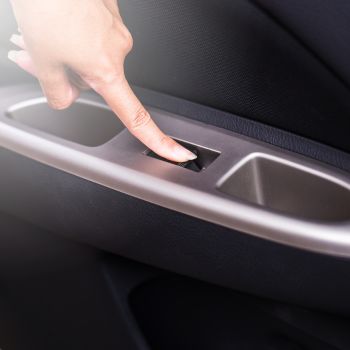 Once upon a time, all cars featured hand-crank windows. By the 1990s, most vehicles were built with an electronic mechanism to roll the windows up and down. Yet this mechanism may stop working due to a mechanical error, blockage or worn parts. If you’re attempting to troubleshoot this issue, here’s what you should know.
Once upon a time, all cars featured hand-crank windows. By the 1990s, most vehicles were built with an electronic mechanism to roll the windows up and down. Yet this mechanism may stop working due to a mechanical error, blockage or worn parts. If you’re attempting to troubleshoot this issue, here’s what you should know.
How Car Windows Roll Down
The standard car window rolls up and down with a metal track secured to the inside of the door. A crank handle or lift motor with a gear or cable-based mechanism causes the glass pane to travel in either direction. For electric or power windows, a switch activates the motor.
Power windows – now considered the standard operational method – started appearing in luxury cars in the 1940s. For several decades after, the majority of standard and economy cars came with a hand crank.
Today, power windows come outfitted with additional features, including sensors to detect and respond to obstructions and automatic operation designed to reduce noise while the car is in motion. Whether the window has a crank or cable-driven system, components can wear over time, become less effective and impede operation.
Why Your Car Windows Aren’t Working
Your car’s power windows may stop working due to one of the following issues:
- Child Safety Switch: This feature prevents a child or pet from accidentally activating the rear or passenger windows. When this feature is turned on, the driver’s window is usually the only one that still works.
- Ignition Switch Issue: If the ignition switch is in the wrong position, the windows won’t roll down. The radio also may not work.
- Blown Fuse: This issue prevents electricity from traveling to the motor mechanism and none of the windows will work. Based on your mechanic skills, you can check your car’s fuse box and attempt to replace it. For newer vehicles, the computer mechanism to keep track of the window’s position may need to be reset.
- Power Switch Issues: A worn power switch no longer operates optimally, becoming loose or staying in one position. These factors can prevent the power circuit from closing, affecting the window’s operation in the process. This issue typically affects the driver’s window before the other three.
- Damaged or Defective Window Motor: The motor may start to experience wear, you hear a loud grinding or whirring sound as it gets close to the end of its lifespan, or notice a louder clicking sound when you press down on the switch.
- Wiring Issues: In addition to other electrical and mechanical issues, the wiring that connects parts of the window system may fray, corrode or break. This issue tends to occur around the door hinge, where wires wear out or break due to routine movement.
- Damaged or Worn Out Components: The seals, guides, weatherstripping and gaskets composing the window’s mechanism are made of rubber and begin to wear out, stick together or loosen. As a result, the windows may operate choppily and allow the elements to enter around the edges. You may also hear a whistling sound while driving, as more air starts to pass between the glass and frame.
- Environmental Issues: Cold, wet weather can cause the guides or frames to freeze or ice may be blocking the pathway for the pane of glass. As such, components will work but the glass won’t lower.
- Car Accident: If an accident has dented one of the doors, the components controlling the window’s movement may have experienced damage and no longer work.
If your car has hand-crank windows:
- Worn-out gears can crack or lose their shape with time or need lubrication and stop lowering or raising the pane of glass.
- The regulator, which transfers the motion of the crank to the window’s lowering mechanism, may get damaged or misaligned. In this case, you may find that you can only raise or lower the window to a point before it appears to get stuck.
- The crank handle may stop turning, potentially due to the track traveling to the regulator.
How to Address a Car Window That Won’t Open or Close
Based on the issues described above:
- Start by checking the child safety locks.
- Test your car’s electronics. If the interior lights and headlights work, the window system may be experiencing electrical issues. If these components don’t work, there could be an issue with the battery, alternator or wiring.
- Look for blockages and damaged components, from ice around the window to torn or loose weatherstripping. In the winter, you may need to wait for snow and ice to melt before you attempt to open the window.
- Try slamming the door or pushing on the glass, which can help realign the glass pane with the window system’s track.
If your windows keep getting stuck or don’t operate properly, make a diagnostic appointment with DaSilva’s Auto Body to have the motor and electrical components examined.




